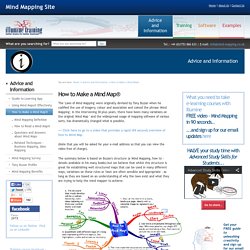

100+ Self-Growth Mind Maps. How to Focus Mind Map. Mindmapping, concept mapping and information organisation software. How to Make a Mind Map® The 'Laws of Mind Mapping' were originally devised by Tony Buzan when he codified the use of imagery, colour and association and coined the phrase 'Mind Mapping'.

In the intervening 30 plus years, there have been many variations on the original 'Mind Map ' and the widespread usage of mapping software of various sorts, has dramatically changed what is possible. >> Click here to go to a video that provides a rapid (99 second) overview of how to Mind Map. (Note that you will be asked for your e-mail address so that you can view the video free of charge). The summary below is based on Buzan's structure (a 'Mind Mapping, how to' - details available in his many books) but we believe that whilst this structure is great for establishing well structured maps that can be used in many different ways, variations on these rules or 'laws' are often sensible and appropriate - as long as they are based on an understanding of why the laws exist and what they are trying to help the mind mapper to achieve.
The Ultimate Guide to Mind Maps and Mind Mapping Tools. What Are Mind Maps?

Mind Maps are a way of visually organizing information that help you identify and understand the structure of a subject at a glance. They allow you to create logical connections between concepts that show how pieces of information fit together, providing you with a “map” of your ideas, processes, and concepts. You can use mind maps for many things such as outlining presentations, ebooks, and content plans, engaging in logical problem solving, and mapping out user experiences online and in the real world. Popularized by British psychologist Tony Buzan, mind maps differ from conventional note taking or planning by presenting a non-linear form, which is moe akin to brain storming and the way the mind creates.
Buzan posits that mind mapping is the most superior form of note taking because it helps avoid the “semi-hypnotic trance” state that other methods induce, i.e., it’s a lot less boring to use than Word. Mind Mapping Best Practices Click here to get MindNode. Crystal Mapping Video Tutorial - Mark Wogan Concept map - Wikipedia, the free encyclopedia - Iceweasel. An Electricity Concept Map, an example of a concept map A concept map or conceptual diagram is a diagram that depicts suggested relationships between concepts.[1] It is a graphical tool that designers, engineers, technical writers, and others use to organize and structure knowledge.

A concept map typically represents ideas and information as boxes or circles, which it connects with labeled arrows in a downward-branching hierarchical structure. The relationship between concepts can be articulated in linking phrases such as causes, requires, or contributes to.[2] Overview[edit] A concept map is a way of representing relationships between ideas, images, or words in the same way that a sentence diagram represents the grammar of a sentence, a road map represents the locations of highways and towns, and a circuit diagram represents the workings of an electrical appliance.
Concept maps were developed to enhance meaningful learning in the sciences. Differences from other visualizations[edit] What is Consciousness? Mind Map on Wikipedia. A mind map about educational technology A mind map is a diagram used to visually organize information.

A mind map is hierarchical and shows relationships among pieces of the whole.[1] It is often created around a single concept, drawn as an image in the center of a blank page, to which associated representations of ideas such as images, words and parts of words are added. Major ideas are connected directly to the central concept, and other ideas branch out from those major ideas.
Mind maps can also be drawn by hand, either as "rough notes" during a lecture, meeting or planning session, for example, or as higher quality pictures when more time is available. Mind maps are considered to be a type of spider diagram.[2] A similar concept in the 1970s was "idea sun bursting".[3] Origins[edit] The semantic network was developed in the late 1950s as a theory to understand human learning and developed further by Allan M. Popularisation[edit] Guidelines[edit] Uses[edit] Research[edit]